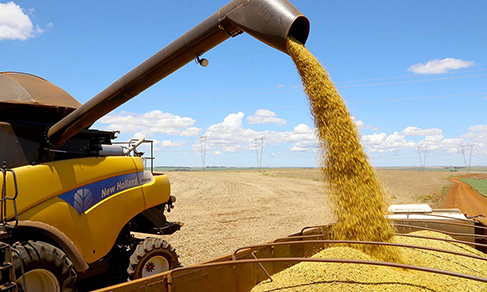Agrlcultural production
August estimate points to a 6.0% drop in the 2024 crop
September 12, 2024 09h00 AM | Last Updated: September 17, 2024 12h22 PM

The Systematic Survey of Agricultural Production (LSPA), released today (12) by the IBGE, shows that the national crop of cereals, legumes and oilseeds should register a 6.0% drop, totaling 296.4 million tonnes in 2024. Compared to July, the estimate indicated a 0.6% reduction with a decrease of 1.7 million tonnes.
The area to be harvested was 78.6 million hectares, showing an increase of 736,017 hectares compared to the area harvested in 2023, a growth of 0.9%. Compared to the previous month, the area to be harvested increased by 8,807 hectares (0.0%).
“The 2024 crop has presented a series of difficulties since its implementation. There was a lack of rain for the production of soybeans and corn, and then an excess of rain, culminating in the floods in Rio Grande do Sul. All of this affected this year's harvest. This is a 6% smaller harvest than last year, which represents 19 million tonnes less. For this month, three crops influenced this reduction. Corn first-crop fell 1.6%, corn second-crop fell 0.6%; and wheat, a crop that is currently in the field, fell 5.4%, which represents 511 thousand tonnes less”, analyzes Carlos Alfredo Guedes, agriculture manager at the IBGE.
Even so, the expectation is that wheat will still have a 16% larger harvest than in 2023, a year in which a record production of the cereal was initially expected, but the adverse weather collapsed the crops and drastically reduced the productivity and quality of the wheat. Mr Guedes indicates that this crop should undergo reviews until December, which is when the harvest ends in Rio Grande do Sul.
Paraná, the second largest national grain producer, with 38 million tonnes, was the state with the greatest losses in August. There were 851.6 thousand less tonnes, a drop of 2.2%. “Another state that suffered a drop in production in August was Santa Catarina, with 450 thousand less tonnes (-6.8%). As a result, several products were revalued, soybeans, corn first-crop, corn second-crop and wheat were the main ones. Beans were also one of the main crops that suffered reductions in Santa Catarina”, adds Mr. Guedes.
According to Carlos Barradas, manager of the LSPA, the result of the 2024 harvest is a combination of low prices for agricultural commodities, climate change with droughts in some producing states and excessive rainfall in others. These changes in the weather have surprised even the forecasts of the competent agencies, which brings additional concerns to producers, since it increases their insecurity. “To close the 2024 crop, we practically need to harvest the winter crops: wheat, oats and barley. This month we are starting to plant the summer crops and there is a lack of rain. Rainfalls are expected by mid-October for the producer to be able to plant and have a good production window. Our first forecast for 2025 will be in November”, notes the LSPA manager.
Compared to 2023, there were increases of 11.2% for upland cotton (seed), which should have a record production; 2.1% for rice; 5.2% for beans and 16.1% for wheat, as well as decreases of 4.4% for soybeans, 11.0% for corn (reductions of 17.1% for 1st crop corn and 9.4% for 2nd crop corn) and 11.3% for sorghum.
Compared to the previous year, there was a 13.6% increase in the area to be harvested for upland cotton (seed), a crop that benefited from low corn prices, leading producers to opt for planting cotton. There was also a 5.0% increase in the area for paddy rice; a 6.0% increase in the area for beans and a 3.2% increase in the area for soybeans, with a 3.3% decrease in the area for corn (reductions of 9.1% for corn 1st crop and 1.5% for corn 2nd crop); a 11.6% decrease in the area for wheat and a 4.7% decrease in the area for sorghum.
For soybeans, the production estimate was 145.3 million tonnes. For corn, the estimate was 116.6 million tonnes (23.0 million tonnes of corn in the 1st crop and 93.6 million tonnes of corn in the 2nd crop). Rice production was estimated at 10.5 million tonnes; wheat at 9.0 million tonnes; cottonseed at 8.6 million tonnes; and sorghum at 3.8 million tonnes.
With a 30.8% share, Mato Grosso leads the national grain production
Mato Grosso leads as the largest national grain producer, with a 30.8% share, followed by Paraná (13.0%), Rio Grande do Sul (11.9%), Goiás (10.6%), Mato Grosso do Sul (7.1%) and Minas Gerais (5.6%), which together accounted for 79.0% of the total. Regarding regional participation, the distribution is as follows: Central-West (48.8%), South (27.0%), Southeast (9.1%), Northeast (8.7%) and North (6.4%).
A series of climate problems have reduced estimates for Brazilian grain production in the 2024 crop. There was a lack of rain and high temperatures during the crop cycle in the summer crop (1st crop) and in the 2nd crop in most of the producing Federation Units. However, the most notable climate event was the excess rain and flooding that occurred in Rio Grande do Sul, which may have removed around 5.0 million tonnes of the Brazilian crops of cereals, legumes and oilseeds this year. The losses were only not greater because most of the rice, soybean and corn crops in Rio Grande do Sul had already been harvested at the time of the event. The IBGE has gathered and is making available a set of information regarding the agricultural harvest in Rio Grande do Sul, which can be accessed at https://www.ibge.gov.br/singedlab/dados-apoio-rs.php.
The next release of the LSPA will be on October 15.
About LSPA
Implemented in November 1972 with the purpose of meeting user demands for monthly statistical information, the LSPA provides estimates of planted area, harvested area, quantity produced and average yield of products selected based on criteria of economic and social importance for the country. It allows not only the monitoring of each crop investigated, from the planting intention phase until the end of the harvest, in the calendar year of reference, but also the forecast for the following year's crops, for which the survey is carried out in the months of October, November and December. Access the data in Sidra.




















